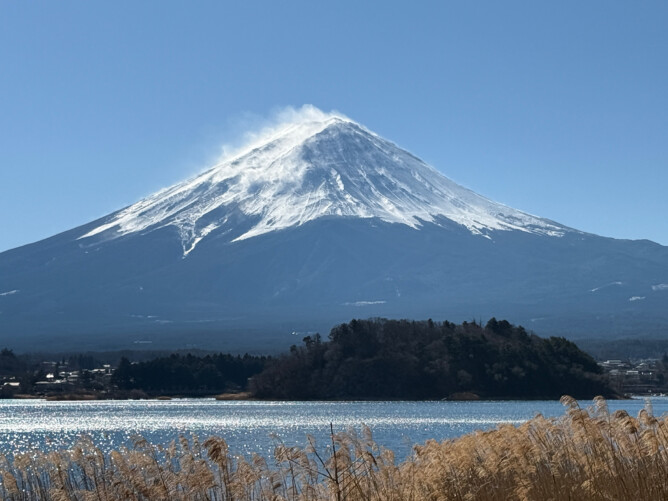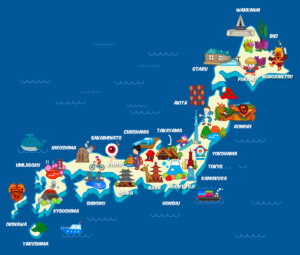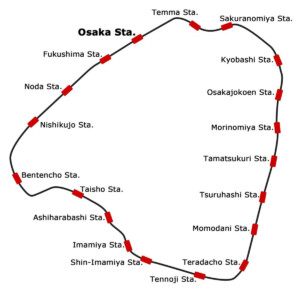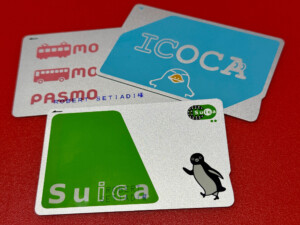
Japan is beautiful and unique, but it can also feel quite different. Planning your first trip to Japan could be quite overwhelming, especially with massive amount of information available online and it is not always easy to figure out where to begin. From places to visit, accommodation, getting around, payment and understanding culture gaps, this post aims to give you a comfortable starting point to your Japan adventure.
First, allow me to start with: Japan is big. It is not a country that you can visit and see everything in a few weeks, or even a few months. Japan might appear small in some common maps because of Mercator projection that do not show country sizes accurately (actual size on Earth sphere vs. size when the map is projected to 2D surface). Driving from Wakkanai (Hokkaido) to Ibusuki (Kagoshima) takes 38 hours (2,800+ kilometres or 1,700+ miles). This is about the same driving distance from Amsterdam (Netherlands) to Athens (Greece), or from New York (NY) to Los Angeles (CA). Hope these comparisons help to give you some idea how big Japan is.
Given how big the country is, you need to be strategic in choosing places to visit.
So what is the best Japan itinerary for first time tourist?
Best itinerary is one you come up yourself after doing some reading, planning and deciding what you want to do most. Everyone’s interests and expectations are different. All the time figuring things out what works best for you before the trip is part of the fun.
Flights
When planning a visit to Japan, I recommend to start with the entry and departure cities. Most people enter or exit Japan from one of the 3 major airports: Haneda (Tokyo), Narita (Chiba) or Kansai (Osaka). Note that Narita is not located in Tokyo, contrary to what many people seems to assume. Narita is located in Chiba, around 1 hour away from Tokyo (70 kilometres or 43 miles). The international airport actually located in Tokyo is Haneda.
Before choosing your flights to Japan, make sure you understand the transportation options from airport. The most popular transport is train, followed by bus and taxi (or Uber). Trains and buses in Japan do NOT run 24 hours. Therefore, it is strongly recommended not to choose a flight that will arrive in Japan in the middle of the night. The same goes for the return flight, choose a schedule during train operating hours. Taxis are available at night, but it would be significantly more expensive.
On arrival in Japan, immigration and customs could take anywhere between 30 minutes to 4 hours. This makes it difficult to estimate the time you can actually get our of the airport. You would want to make sure your arrival time plus 4 hours is still within train operating hours. Train from Haneda does not require pre-purchased tickets, just use Suica card or buy paper tickets using cash. Train from Narita requires separate ticket (Narita Express) but generally can be purchased on site when we are ready to depart. Train from Kansai depends on the location of your accommodation, since Kansai basically serves people staying in Osaka and Kyoto.
It is also worth to note that you do not have to enter and exit Japan from the same city. Bullet train (shinkansen) or domestic flight are not cheap (shinkansen from Tokyo to Osaka costs almost 14,000 JPY one way per adult). This cost quickly adds up especially for a large group. Therefore, if optimising time is essential for you, there is no need to return to a city you already visited and pay additional set of shinkansen tickets.
For easy access to public transport, you might want to get a Suica card from Haneda or Narita, or an Icoca card from Kansai. Alternatively, Tokyo also sells Welcome Suica, which is a special type of Suica card that would expire in 28 days. If you decide to get these cards after leaving the airport, most major train stations also have them, either from ticket office or from machines (with English menu). Some train stations outside the JR network also sell Pasmo card in Tokyo. These cards work nationwide, but balance can only be processed in the city where the card was purchased (and no refund at all for Welcome Suica). More about these cards in a separate post about Japan public transport.
Cities and Main Attractions

With such large area, it is important to decide which places to visit. The choice of cities are often lined to the main attraction that someone wants to visit. For example, people wanting to go to Universal Studios Japan would consider to stay in either Osaka or Kyoto. People who wants to visit Tokyo Disney Resort would likely stay somewhere in Tokyo.
Tokyo
Tokyo is the capital of Japan and by far the largest city. This city is a metropolitan area, very busy and heavily populated. Some popular attractions in Tokyo include Imperial Palace, Meiji Jingu Shrine, Senso-ji Temple Asakusa, Skytree, Tokyo Tower, Shibuya Crossing, Shinjuku Gyoen Park, Ueno Park, Akihabara Electric Town, Ginza, Harajuku, Odaiba and many more. Tokyo Disney Resort is located short distance from Tokyo, where we can visit Tokyo Disneyland or Tokyo DisneySea. While there are other Disneyland Parks in the world, Tokyo DisneySea is the only one in the world. Some people also enjoy visiting teamLab Borderless, teamLab Planets, Sanrio Puroland, Shibuya Go Kart, Tokyo Joypolis, or doing a daytrip to Mount Fuji.
Kyoto
Kyoto is the old capital of Japan, a very traditional city rich in culture. Some popular attractions in Kyoto include Kyoto Imperial Palace, Nijo Castle, Kiyomizu-dera (and its surrounding Higashiyama area), Kinkakuji Shrine, Ginkakuji Shrine, Fushimi Inari Shrine, Tofukuji Temple, Arashiyama and many more. Many people take day-trip to Nara to see Deer Park.
Osaka
Osaka is the second largest metropolitan city after Tokyo. Some popular attractions in Osaka include Osaka Castle, Umeda, Namba, Dotonbori, Shitennoji Temple, Sumiyoshi Taisha Shrine, Universal Studios Japan and many more. Popular day-trips from Osaka include Kyoto, Kobe and Nara. Osaka is popular for its street food and vibrant night-life.
Other Cities
Some people visits Nagoya for the Ghibli Museum or Legoland. Others go to Hiroshima or Nagasaki to visit World War II Memorial. In winter, people go to Sapporo for its snow festival. Many other cities offer unique attraction that might interest some individuals. The locations listed in this post are just a few starter to help first time visitors. They are far from a complete list of what Japan has to offer. It is also important to remember the time of visit, as some places have special things to do specific to the season, such as autumn in Nikko and winter in Hokkaido.
Identifying the main attractions will help us to divide how many days to stay in each city. This will help to start searching for accommodation. There is no need to have full itinerary of every place to visit from the beginning.
Accommodation
After choosing on some main attractions, next step of trip planning is deciding how many nights to stay in each city. Since this post is written mainly for first time visitors, the focus is limited to the 3 most popular cities: Tokyo, Kyoto and Osaka.

In Tokyo, there is one popular train line called JR Yamanote Line. This train line is a loop and it stops at several key locations in Tokyo. First time visitors are usually advised to choose a hotel/accommodation within walking distance to one of the stations within this line. Popular area around Yamanote Line are Tokyo, Shinagawa, Ueno, Ikebukuro, Shinjuku and Shibuya. If you plan to take bullet train (shinkansen) to Osaka or Kyoto, you can start from either Tokyo Station or Shinagawa Station. Narita Express train stops at Tokyo Station, Hamamatsucho Station, Shinagawa Station, Shibuya Station and Shinjuku Station. Haneda Monorail to Haneda Airport stops at Hamamatsucho Station. Some people prefer to stay in Asakusa area, which is outside JR Yamanote Line, but is connected by Asakusa Line, arguably the second most popular train line for tourists. Different area offers different vibe. Some people prefers more touristy areas, others prefer more quiet areas, there is no single “best” place, it all depends on individual preference.
Before booking an accommodation, make sure to search the location in Google Maps and identify how far it is from the nearest train station that matters for you, do not just trust listing item saying “2 minutes from train station” but the train station do not have access to popular train lines.
To stay in Tokyo, we also need to pay accommodation tax. This is calculated based on our accommodation cost per night per person before tax. If the cost is under 10,000 yen (per person per night), then we do not need to pay additional accommodation tax. If it is between 10,000 to 15,000 yen, we need to pay 100 yen per night. If it is above 15,000 yen (per person per night), the additional tax is 200 yen per night. This tax cannot be paid as part of your hotel booking, you will need to pay this separately when you do hotel check-in upon arrival. In Tokyo, some private lodging (such as AirBnB) are not subject to this tax.
In Kyoto, basically Kyoto Station is the hub of all train lines. Staying near Kyoto Station will give you best experience with transport, but likely is also the most expensive. JR Kyoto Line, JR Nara Line, and JR Sagano Line would take you to most places, in combination with buses or occasional subway lines. Personally I feel that some buses are more convenient to reach some popular temples and shrines.
Accommodation tax is more expensive in Kyoto, which has the highest accommodation tax in Japan. With no free tier, people with accommodation cost below 20,000 yen per person per night needs to pay 200 yen per night tax. Accommodation from 20,000 to 50,000 yen per person per night gets 500 yen per night tax. More expensive accommodation (above 50,000 yen per person per night) must pay additional 1,000 yen per night tax. Private lodgings such as AirBnB are also subject to this tax in Kyoto.

In Osaka, most people could get around well using Osaka Loop Line. If Universal Studios Japan is an important destination for you, I suggest choosing accommodation near Universal City to allow quick travel in the morning. Otherwise, places near train stations in Osaka Loop would do just fine.
It is important to note that Osaka Station is different from Shin-Osaka Station. Bullet train (shinkansen) stops at Shin-Osaka Station, but the main station in Osaka Loop is Osaka Station. There are connecting trains between the two.
Similar to Tokyo and Kyoto, Osaka also has accommodation tax. Under 7,000 yen per person per night gets no additional tax. Between 7,000 to 15,000 yen per person per night gets 100 yen per night. Between 15,000 to 20,000 yen per person per night must pay 200 yen per night. Above 20,000 yen per person per night pays 300 yen per night of additional tax. Just like Kyoto, private lodgings in Osaka are also subject to this tax.
Getting Around
The most popular method of transport in Japan is by trains/subways. There are multiple companies operating different lines in Japan. The term “train” is commonly used for on-the-ground lines, and the term “subways” are commonly used for underground lines. For most people, it does not matter which company operates a certain train lines because they all accept IC card payment (such as Suica, Pasmo, Icoca, etc).
There are 3 types of trains from ticketing perspective: local train (short distance), limited express train (for long distance trips), and bullet train (for fast travel between cities). Many tourists are getting passes hoping to save money in their transport costs while in Japan. Japan Rail Pass (JR Pass) is the most popular pass because it offers unlimited rides on all JR lines nationwide. You can google “JR Pass calculator” and use one of the calculators available to find out if you will save money or actually end up paying more.

Visa/Master credit/debit cards are not accepted in majority of train stations. To travel with (local) train, there are 2 options of payment: using cash to buy paper tickets from machines, or using Suica (or any other IC card).
Other than trains, some areas are achievable by bus. Before getting on a bus, either read some instruction or observe other passenger, one door is usually for entry and the other door is for exit. Buses accept Suica (or other IC card), but the fare is usually one flat fare. Therefore only 1 tap is required, different from trains, which require a pair of taps: at starting station (entry gate) and at destination station (exit gate). Some buses also accept cash or credit card payment.
Google Maps is super useful in Japan. It provides detailed information for train and bus routes, complete with how to get to the correct platform and how much the trip will cost. Signs are provided in Japanese and English in major train stations and most tourism areas. Google Translate has camera feature that can be used to translate signs you are not sure about.
Taxi is easily available through Taxi Go app. It offers convenient way to order taxi, the app is available in English and since destination address is already entered in the app, there is no need to worry about language barrier with the taxi driver (many drivers do not speak English). Uber is available in Japan, but in many circumstances it would arrange normal taxi because Japan law restrict individual (private) contractors providing transport services in many locations during certain times.
Renting a car is also an option. To drive in Japan, you will need to bring 3 items: your passport, driver license, and international driving permit. You need to obtain international driving permit before the trip, in your home country. Different countries have different rules about international driving permit. Use google to find out more about how to obtain it in your country.
Booking Attraction Tickets
Japan tourism significantly increases in the last several years. As a result, many areas are overcrowded and entry tickets for popular attractions have the tendency to sold out early. It is generally advisable to book your tickets before the trip to avoid disappointment, unless it you are super flexible with what you get to see there. When possible, booking from official website is always recommended. However, some official websites do not have good ticketing system with English language option. Some others literally directed visitors to purchase tickets from some third party partners.
Some third party websites (such as Klook) would charge us in our home currency instead of JPY. This could be preferred scenario for some. There are cases where official websites offer more variety of ticketing options compared to third parties, but sometimes I would find special offer only available from third party sites. Another factor to consider is availability. Sometimes tickets for a venue will run out from one source but still available from another. Basically: shop around first, understand your options before making purchase.
Payments
To get best experience in today’s Japan, you will need a combination of:
- JPY cash
- Credit/debit card (Visa/Master/Amex)
- IC card (Suica, Pasmo, Icoca, etc)
Many places accept credit/debit card payments, especially in big cities. The further you are from big cities or major tourism spots, the more likely you will encounter shops and restaurants that only accept cash. Majority of train stations in Japan do not accept Visa/Master credit/debit card as payment. Your choice is either use cash to purchase paper ticket from the ticket machines, or use Suica (or other IC card) to tap on the entry and exit gates.
Japan does not have topping culture. Basically no tip, even for good service. It is strongly recommended to not even try. Some will feel offended, some will refuse it politely, some could lose their job for accepting tip, yet there are some that will accept it for various reasons. Physical gifts are given to people we know personally, such as friends or relatives, not to strangers providing services to us. Best form of appreciation is by polite thank you, bow a little bit, be respectful and genuine attempt of few words of Japanese. I know it is hard to comprehend for some, but places where appreciation is not expressed/associated with physical goods or money do exist. Japan is one of those places.
Where and when to exchange money to JPY?
There is no hard right or wrong answer for this question. It depends. Some currencies could have better rates if exchanged in Japan, and vice versa. Also, if you know a good money changer in your home city that is usually do good exchange rates, chances are it would be preferred to most money exchanges in Japan. If you do decide to exchange in Japan, I would still recommend to bring at least 10,000 JPY at the time of arrival just in case.
What to Bring
When it comes to packing, it is important to come prepared, but also do not bring too much.
- Clothing. Dress for the season. Clothing for summer visit is obviously different from winter holiday. Summer in Japan can be really hot and humid. Winter are cold, but snow is rare in Tokyo, Kyoto and Osaka. To see some serious snow, consider Sapporo (or Hokkaido in general), or one of the snow resorts in Northern parts of Honshu island. Many hotels provide coin laundry machines. Bring enough clothing for a week, and do laundry there if the holiday is longer. Some people feel that laundry machines in hotels take too long to dry the clothing. If this is your case, you can also go to some coin laundry locations that has newer machines. Several locations in major cities offer modern wash-and-dry in a machine and they are really good.
- Shoes. Bring comfortable shoes because you will walk a lot during your time in Japan, usually around 15k to 20k steps per day or more. Some people likes to bring 2 pairs of shoes and rotate during the trip, but I personally feel that luggage space is too precious for that.
- Chargers. This one is obvious, you would want to make sure your phones or tablets are functional during your holiday.
- AC adapter. Japan uses type A plug, which is dual flat parallel pins. Most electricity plugs in hotels do not have the third hole for grounding pin (type B). Most modern chargers (for smartphones, tablets and laptops) would work fine. For hair dryers or hair straighteners, make sure your product supports 100V supply voltage and 50/60Hz.
- JPY cash. I strongly recommend to bring at least a bit of yen at the time of arrival. Regardless of how you might hear that places in Japan accept credit cards now, there are still things that require cash. Some shops and restaurants are still cash only. Buying paper tickets for local trains and topping up Suica (or other IC cards) balance require cash.
- Medicine. Visitors are allowed to bring up to one month supply of medicine for personal use. Please make sure to check the latest list from Japan’s Ministry of Health, Labour and Welfare to check if your medicine contains any ingredient from their list, in which case you must apply for written permission before the trip. It is important to understand that some ingredients that are completely legal in your home country might be illegal in Japan. Bringing doctor’s prescription from your home country does not exempt you from getting written permission prior to your entry to Japan.
- Passport. It is legal requirement by Japan law that visitors must carry their passports at all times.
- Empty space in the luggage to bring home the shopping items and souvenirs.
- Print-out of this post. Lol, just kidding on this one.
Internet Connectivity
You will need Internet connectivity while in Japan. At the very minimum is to navigate with Google Maps, and to use Google Translate. Generally people can choose from:
- Using the mobile number from home and pay its international roaming costs. Some providers offer plan that charges capped costs of $5, $10 or $12 per day. Even though this seems to be low, it adds up quickly even for a week’s trip.
- Use data-only SIM. This will give you Internet connectivity while in Japan, but no Japanese number. You can still call each other using WhatsApp, FaceTime or other Internet-based apps. Data-only SIM can come in physical SIM card, or it can come in eSIM (added to your phone using QA code or using app). You need to have network-unlocked phone to be able to use data-only SIM. Popular eSIM services include Airalo, Ubigi, GigSky, TravelKon and many more.
- Use voice-and-data SIM. This will give you Internet connectivity to use in Japan and Japanese mobile number. Using this, you can call land-line numbers including business phones and emergency services. Japan law makes it harder for tourists to obtain voice-and-data SIM because it requires more data and formal registrations. However, there are some providers such as Mobal and Sakura Mobile that offer voice-and-data connection for longer visits (90 days or more). Modal has special SIM with voice and data for shorter visits, offering 30, 60 or 90 days with no ongoing subscription. Similar to data-only SIM, voice-and-data SIM can come in physical SIM card or it come as eSIM. You also need an unlocked phone.
- If your phone is network-locked, but you do not wish to pay international roaming costs, you have the option to rent pocket wifi. This is a small device that will provide Internet connectivity to a few devices nearby the pocket wifi unit. Typically we can book for this pocket wifi before our arrival, then we pick up the device at the airport, then you need to return the unit before you fly back home.
Accessibility
Most major stations have lifts (elevators) at at least one of their exits. This means if your destination is closer to a different exit, you might only see normal stairs and have to make a long detour to find the lift. There are online maps available for major train stations. This can be particularly useful for some large-and-complex stations such as Tokyo Station and Shinjuku Station. Not all restaurants would have accessibility ramp, sometimes it is because of technical limitation of the building or their location, not because they do not want to provide. Many public places have bright coloured special tiles for people with vision impairment.
Others
It will not hurt to learn a few basic words of Japanese. Many Japanese people cannot speak English well enough for a conversation, even those who can, they always appreciate if we start our question with “sumimasen” and end it with “arigatou gozaimasu”. Language barrier is at most minor inconvenience with the help of modern technology (Google Translate is your best friend). What is important is to stay respectful and kind.
Lastly, the information in this post are based on my knowledge at the time of writing. Things can change. This article is written to help first time visitors with a starting point to plan their trips. Always check with official sources for latest information when doing the actual planning.

Leave A Comment